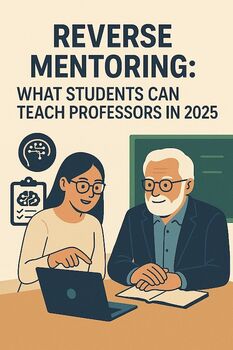Here Is What Students Can Share with Professors in 2025
Between 2025 and 2030, there will be big changes in how students and professors interact and work together. Students now participate in new ways, using technology, leading the field and supporting their professors with their insights.
Here’s how students are transforming education and what professors can gain from them.
1. Mastering Emerging Technologies
At present, students have grown up surrounded by digital technology. Students usually pick up new technologies like ChatGPT, Midjourney and GitHub Copilot faster than schools can, which includes learning in virtual reality.
Professors are able to find out how technology is improving research, writing, design and coding — and see how to use these changes in teaching.
Example uses include using AI for generating ideas, creating summaries from texts and writing code for homework. When using these tools, professors can encourage student participation and prepare them well for their future jobs.
2. Leading with Collaboration and Community
Today’s students excel in building collaborative digital communities.
They form study groups on Slack, Discord, and Teams, sharing notes, solving problems together, and supporting each other around the clock.
Professors can learn how to harness this natural sense of community by creating digital spaces where students can collaborate easily, turning classrooms into vibrant hubs of peer learning rather than one-way lecture halls.
3. Embracing Microlearning and Personalization
Students in 2025 prefer brief, personalized learning experiences to long lectures. These students are true to the microlearning approach — utilizing short videos, games, and tutorials that fit within their busy mobile-first lifestyles.
Professors can use microlearning techniques, including more visuals, gamification, and adaptive learning paths, to bring their teaching into line with how students learn today and take engagement to a new level.
4. Innovating with AI and Critical Thinking
Students are not simply implementing AI-tools They are engaging critically with them.
Students approach AI-generated material knowing its strengths and weaknesses, and explore ethical use cases in research, writing, and coding.
Professors can work with students to create assignments using AI intentionally, where critical analysis, creativity, and ethics is at the focus. Instead of fighting AI, welcoming it as a partner in learning could open powerful, exciting new opportunities for deeper thinking.
5. Shaping Education Through Feedback and Co-Creation
Contemporary learners want to co-create their educational experiences. They desire transparency, personalized feedback, and active participants in shaping course content and assessments. Lecturers who pay attention to student voices — whether through course surveys, open forum opportunities or collaboratively designing projects together — develop trust, and build stronger, more dynamic, and student-centered models of education.
In 2025, the landscape of education is not about professors “keeping pace” with students, but about learning in partnership with students. Students are reshaping functionality of technology, collaboration and critical thinking!
Professors that consciously embrace this shift — who view students as partners in learning rather than simply students — will develop more meaningful, responsive, and future-oriented learning experiences. In a time of great complexity and change, the best educators will be the best learners, and values and learning traits of great educators sometimes arise from the best students — who simply taking notes, construct coding projects, and upload TikTok explainers.
Source : https://lambtoncollege.libguides.com/researching/search/tips


